一、前期准备:环境配置与数据加载
我用夸克网盘给你分享了「肝癌预测数据集和相关代码模型」,链接:https://pan.quark.cn/s/5ccf66c17f2d
kaggle源地址:https://www.kaggle.com/datasets/miadul/predict-liver-cancer-from-and-clinical-features

1. 依赖库
pandas/numpy:数据读取、清洗与数值计算;matplotlib/seaborn:数据可视化;scikit-learn:经典机器学习模型(逻辑回归、随机森林等)与评估工具;xgboost:高效的梯度提升树模型(适合医疗数据分类);shap:模型可解释性分析(医疗场景需明确"哪些特征导致癌症预测")。
没有安装上述依赖库可以安装一下,例如:
pip install shap2. 加载数据并初步探查
通过pandas读取CSV文件,查看数据基本信息(维度、缺失值、数据类型),避免后续因数据格式问题报错:
python
import pandas as pd
import numpy as np
# 加载数据(需替换为你的数据集本地路径)
df = pd.read_csv("predict_liver_cancer.csv")
# 1. 查看数据前5行,了解特征分布
print("数据前5行:")
print(df.head())
# 2. 查看数据维度(行数×列数)
print(f"\n数据维度:{df.shape}") # 预期输出 (5000, 14)
# 3. 检查缺失值(该数据集为合成数据,通常无缺失,但需验证)
print("\n各列缺失值数量:")
print(df.isnull().sum())
# 4. 查看数据类型与统计描述
print("\n数据类型:")
print(df.dtypes)
print("\n数值型特征统计描述:")
print(df.describe()) # 仅显示age、bmi等数值列的均值、标准差、分位数等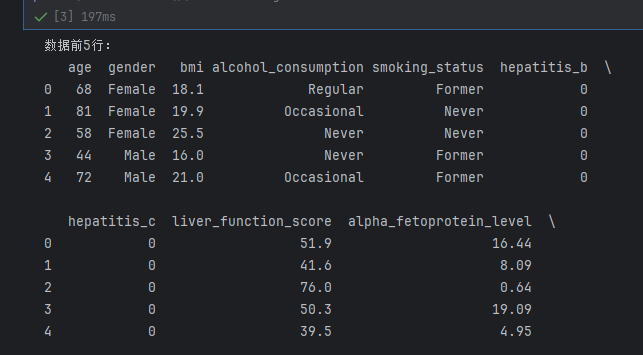
3. 目标变量分布检查
该任务为二分类问题 (预测是否患肝癌:liver_cancer=1/0),需先确认正负样本是否平衡(避免模型偏向多数类):
python
# 统计目标变量数量与占比
target_count = df["liver_cancer"].value_counts()
print("目标变量分布:")
print(target_count)
print(f"患癌比例:{target_count[1]/len(df):.2%}")
print(f"未患癌比例:{target_count[0]/len(df):.2%}")
# 可视化目标变量分布(用饼图更直观)
import matplotlib.pyplot as plt
plt.pie(target_count, labels=["无肝癌", "有肝癌"], autopct="%1.1f%%", colors=["#66b3ff", "#ff9999"])
plt.title("肝癌诊断结果分布")
plt.show()- 如果两类样本比例差异过大(如患癌样本<10%),后续建模需用SMOTE过采样 或类权重调整 (如
class_weight='balanced')解决 imbalance 问题。
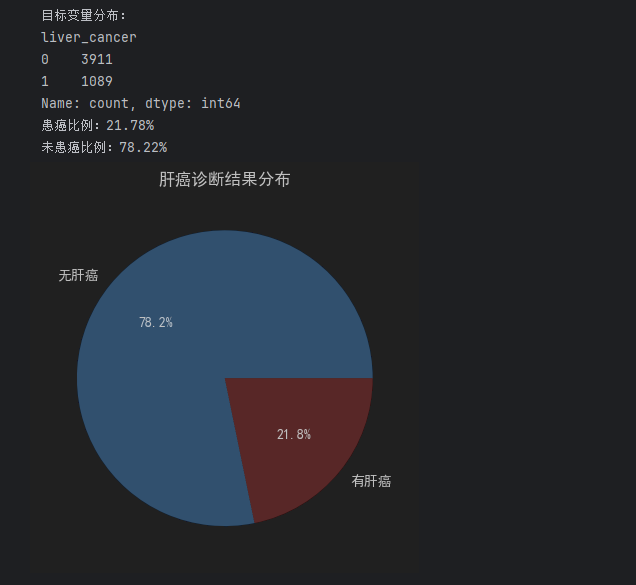
二、核心环节1:探索性数据分析(EDA)
EDA是理解数据的关键,需从单特征分布、特征与目标的关联、特征间相关性三个维度展开,挖掘医疗数据中的潜在规律(如"肝炎患者是否更易患肝癌""BMI与肝癌的关系")。
1. 数值型特征分析(年龄、BMI、肝功能评分等)
重点查看数值特征的分布形态,以及不同肝癌诊断结果下的特征差异:
python
import seaborn as sns
# 定义数值型特征列表(从数据集描述中提取)
numeric_features = ["age", "bmi", "liver_function_score", "alpha_fetoprotein_level"]
# 1. 绘制数值特征的直方图(按肝癌诊断分组,对比分布差异)
fig, axes = plt.subplots(2, 2, figsize=(12, 10))
axes = axes.flatten() # 展平子图数组,便于循环
for i, feat in enumerate(numeric_features):
# 无肝癌组
sns.histplot(df[df["liver_cancer"]==0][feat], ax=axes[i], label="无肝癌", color="#66b3ff", alpha=0.7)
# 有肝癌组
sns.histplot(df[df["liver_cancer"]==1][feat], ax=axes[i], label="有肝癌", color="#ff9999", alpha=0.7)
axes[i].set_title(f"{feat} 分布对比")
axes[i].legend()
plt.tight_layout()
plt.show()
# 2. 统计不同肝癌状态下数值特征的均值(医疗场景中"均值差异"有临床意义)
numeric_stats = df.groupby("liver_cancer")[numeric_features].mean()
print("不同肝癌状态下数值特征的均值:")
print(numeric_stats)- 关键观察点:例如
alpha_fetoprotein_level(甲胎蛋白,临床肝癌标志物)在"有肝癌"组的均值应显著高于"无肝癌"组,若符合则数据逻辑合理。
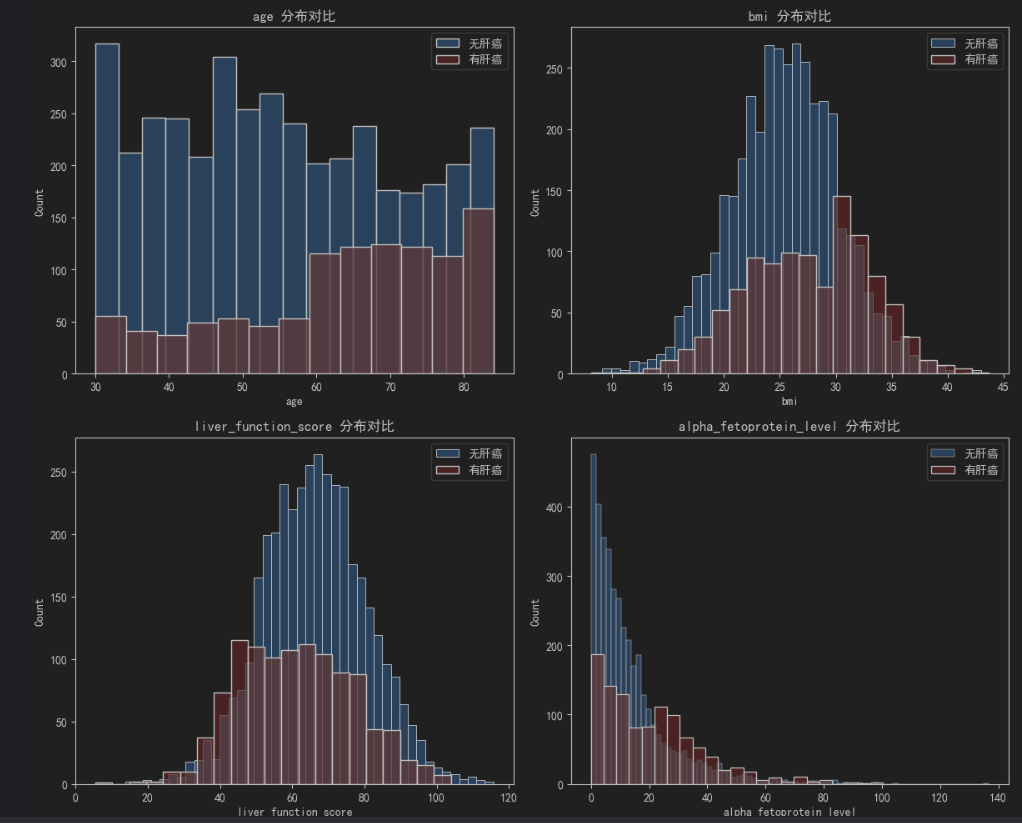
2. 分类型特征分析(性别、饮酒、吸烟、肝炎史等)
分类型特征需用交叉表 或条形图分析其与肝癌的关联(如"男性vs女性的患癌率""有乙肝vs无乙肝的患癌率"):
python
# 定义分类型特征列表(含二分类特征如hepatitis_b,及多分类如alcohol_consumption)
cat_features = ["gender", "alcohol_consumption", "smoking_status", "hepatitis_b", "hepatitis_c", "cirrhosis_history", "family_history_cancer", "physical_activity_level", "diabetes"]
# 循环分析每个分类型特征与肝癌的关联
for feat in cat_features:
# 1. 计算交叉表:特征类别 × 肝癌状态,得到数量分布
cross_tab = pd.crosstab(df[feat], df["liver_cancer"], normalize="index") # normalize="index" 计算每行占比(即该类别的患癌率)
print(f"\n{feat} 与肝癌的关联(每行表示该类别的患癌率):")
print(cross_tab.round(3) * 100) # 转为百分比,保留1位小数
# 2. 可视化:条形图展示不同类别的患癌率
plt.figure(figsize=(10, 5))
cross_tab[1].plot(kind="bar", color="#ff6b6b") # 只展示"患癌率"(liver_cancer=1的列)
plt.title(f"{feat} 不同类别的肝癌患病率")
plt.xlabel(feat)
plt.ylabel("肝癌患病率(%)")
plt.xticks(rotation=45)
plt.grid(axis="y", alpha=0.3)
plt.show()- 关键医疗逻辑验证:例如
cirrhosis_history(肝硬化史)、hepatitis_b(乙肝)组的患癌率应显著高于无病史组,若符合则数据符合医学常识。
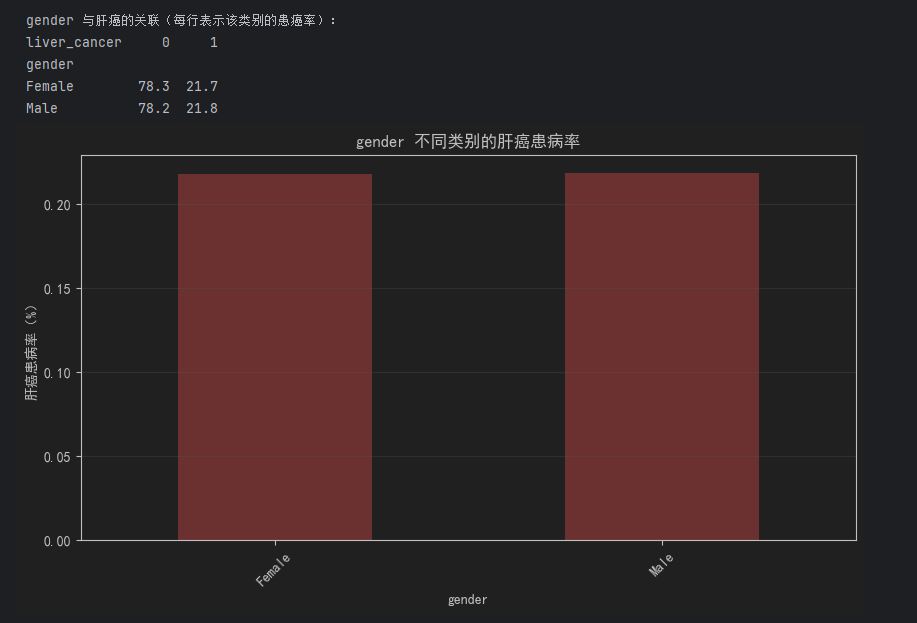
3. 特征间相关性分析
通过热力图查看特征间的线性相关程度,避免建模时的"多重共线性"问题(如两个高度相关的特征可能导致模型系数不稳定):
python
# 先将分类型特征转为数值型(one-hot编码),再计算相关系数
df_encoded = pd.get_dummies(df.drop("liver_cancer", axis=1), drop_first=True) # drop_first避免虚拟变量陷阱
df_encoded["liver_cancer"] = df["liver_cancer"] # 加回目标变量
# 计算Pearson相关系数
corr_matrix = df_encoded.corr()
# 可视化热力图(重点关注与目标变量的相关性)
plt.figure(figsize=(14, 12))
sns.heatmap(corr_matrix, annot=False, cmap="coolwarm", fmt=".2f", linewidths=0.5)
plt.title("特征间相关性热力图")
plt.show()
# 提取与"肝癌"相关性Top10的特征(按绝对值排序)
target_corr = corr_matrix["liver_cancer"].drop("liver_cancer").abs().sort_values(ascending=False)
print("与肝癌相关性Top10的特征:")
print(target_corr.head(10))- 预期结果:
alpha_fetoprotein_level(甲胎蛋白)、cirrhosis_history(肝硬化史)、hepatitis_b/c(肝炎)应与目标变量相关性最高,符合临床认知。
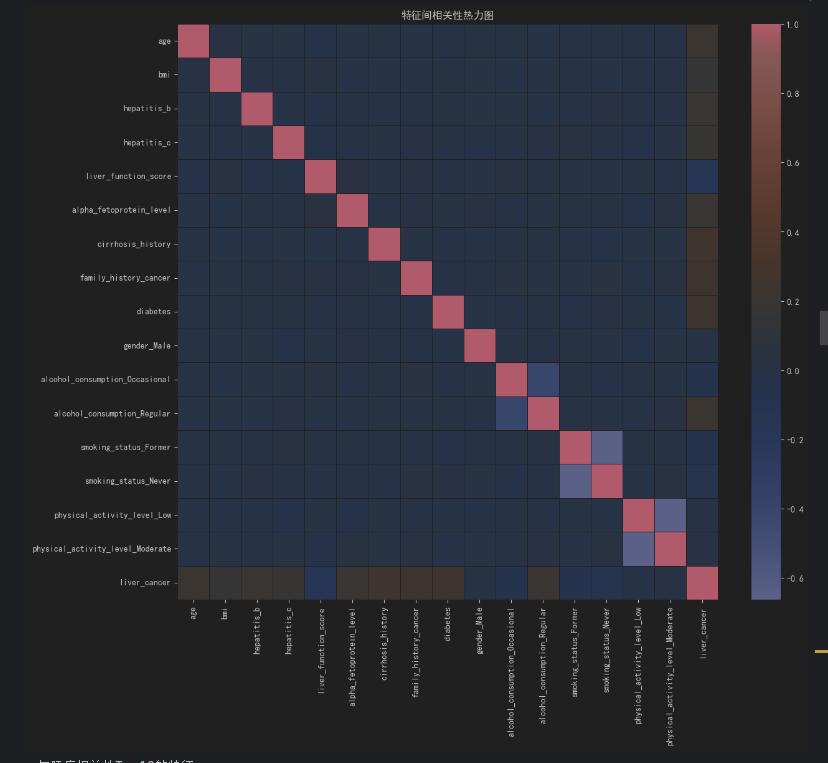
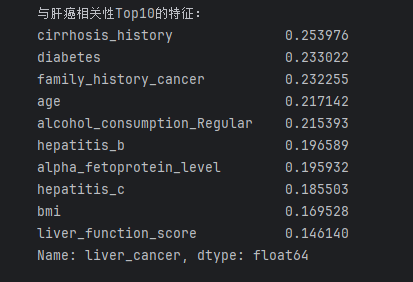
三、核心环节2:数据预处理
医疗数据需处理分类型特征编码、数值型特征标准化、样本平衡,确保模型输入格式正确且训练稳定。
python
from sklearn.model_selection import train_test_split
from sklearn.preprocessing import StandardScaler
from imblearn.over_sampling import SMOTE # 处理样本不平衡
# 1. 分离特征(X)和目标变量(y)
X = df.drop("liver_cancer", axis=1)
y = df["liver_cancer"]
# 2. 分类型特征编码(one-hot编码,适用于无顺序的类别如gender、alcohol_consumption)
X_encoded = pd.get_dummies(X, drop_first=True) # drop_first=True:避免多重共线性(如Male=1则Female=0,无需保留Female列)
# 3. 划分训练集和测试集(8:2分割,保证数据分布一致)
X_train, X_test, y_train, y_test = train_test_split(
X_encoded, y, test_size=0.2, random_state=42, stratify=y # stratify=y:按目标变量分布分层,保证训练/测试集患癌率一致
)
# 4. 数值型特征标准化(对逻辑回归、SVM等敏感模型必要,消除量纲影响)
# 先筛选数值型特征列(从原始X中提取)
numeric_cols = ["age", "bmi", "liver_function_score", "alpha_fetoprotein_level"]
# 对应到编码后的X_train/X_test的列名(如无变化,直接用原列名)
numeric_cols_encoded = [col for col in numeric_cols if col in X_train.columns]
# 初始化标准化器,仅对数值列标准化
scaler = StandardScaler()
X_train[numeric_cols_encoded] = scaler.fit_transform(X_train[numeric_cols_encoded])
X_test[numeric_cols_encoded] = scaler.transform(X_test[numeric_cols_encoded]) # 测试集用训练集的均值/标准差,避免数据泄露
# 5. 处理样本不平衡(若之前发现患癌样本占比<15%,用SMOTE过采样)
print(f"过采样前训练集患癌样本占比:{y_train.sum()/len(y_train):.2%}")
smote = SMOTE(random_state=42)
X_train_resampled, y_train_resampled = smote.fit_resample(X_train, y_train)
print(f"过采样后训练集患癌样本占比:{y_train_resampled.sum()/len(y_train_resampled):.2%}") # 预期为50%四、核心环节3:机器学习建模与评估
医疗场景中,模型的召回率(Recall,避免漏诊)、精确率(Precision,避免误诊)、AUC(整体区分能力) 是关键指标。推荐从"简单基准模型"到"复杂模型"逐步迭代,对比效果。
1. 模型选择与训练
推荐4类适合医疗二分类的模型,覆盖不同复杂度:
| 模型类型 | 特点 | 适用场景 |
|---|---|---|
| 逻辑回归 | 简单可解释,能输出概率 | 基线模型,快速验证数据有效性 |
| 随机森林 | 抗过拟合,对异常值鲁棒 | 处理非线性关系,特征重要性易获取 |
| XGBoost | 梯度提升,精度高,适合小样本医疗数据 | 追求高预测精度 |
| 支持向量机(SVM) | 高维数据表现好 | 特征维度高、样本量适中的场景 |
以下是核心代码(以逻辑回归和XGBoost为例):
python
from sklearn.linear_model import LogisticRegression
from xgboost import XGBClassifier
from sklearn.metrics import (
accuracy_score, precision_score, recall_score, f1_score, roc_auc_score,
confusion_matrix, classification_report, roc_curve
)
# ---------------------- 1. 基准模型:逻辑回归 ----------------------
lr_model = LogisticRegression(class_weight="balanced", max_iter=1000, random_state=42)
lr_model.fit(X_train_resampled, y_train_resampled)
# 预测(输出概率,便于后续计算AUC)
y_pred_lr = lr_model.predict(X_test)
y_pred_proba_lr = lr_model.predict_proba(X_test)[:, 1] # 患癌的概率
# ---------------------- 2. 高精度模型:XGBoost ----------------------
xgb_model = XGBClassifier(
objective="binary:logistic", # 二分类任务
eval_metric="auc", # 评估指标用AUC
random_state=42,
learning_rate=0.1,
n_estimators=100
)
xgb_model.fit(
X_train_resampled, y_train_resampled,
eval_set=[(X_test, y_test)], # 验证集
early_stopping_rounds=10, # 早停:10轮无提升则停止,避免过拟合
verbose=False
)
# 预测
y_pred_xgb = xgb_model.predict(X_test)
y_pred_proba_xgb = xgb_model.predict_proba(X_test)[:, 1]2. 模型评估(医疗场景重点关注漏诊/误诊)
用混淆矩阵、分类报告、ROC曲线 全面评估模型,尤其关注recall(漏诊率=1-recall,越低越好)和precision(误诊率=1-precision,越低越好):
python
# 定义评估函数,简化代码
def evaluate_model(y_true, y_pred, y_pred_proba, model_name):
print(f"=== {model_name} 评估结果 ===")
# 混淆矩阵(TP:真阳性,TN:真阴性,FP:假阳性,FN:假阴性)
cm = confusion_matrix(y_true, y_pred)
print("混淆矩阵:")
print(cm)
# 关键指标
print(f"准确率(Accuracy):{accuracy_score(y_true, y_pred):.4f}")
print(f"精确率(Precision):{precision_score(y_true, y_pred):.4f}") # 预测为患癌的人中,实际患癌的比例(避免误诊)
print(f"召回率(Recall):{recall_score(y_true, y_pred):.4f}") # 实际患癌的人中,被正确预测的比例(避免漏诊)
print(f"F1分数:{f1_score(y_true, y_pred):.4f}") # 精确率和召回率的调和平均
print(f"AUC值:{roc_auc_score(y_true, y_pred_proba):.4f}") # 整体区分能力(0.9以上为优秀)
# 分类报告(含每个类别的指标)
print("分类报告:")
print(classification_report(y_true, y_pred))
# 绘制ROC曲线
fpr, tpr, _ = roc_curve(y_true, y_pred_proba)
plt.plot(fpr, tpr, label=f"{model_name} (AUC = {roc_auc_score(y_true, y_pred_proba):.4f})", linewidth=2)
# 评估两个模型
evaluate_model(y_test, y_pred_lr, y_pred_proba_lr, "逻辑回归")
evaluate_model(y_test, y_pred_xgb, y_pred_proba_xgb, "XGBoost")
# 绘制ROC曲线对比
plt.plot([0, 1], [0, 1], "k--", label="随机猜测(AUC=0.5)")
plt.xlabel("假阳性率(FPR)")
plt.ylabel("真阳性率(TPR)")
plt.title("肝癌预测模型ROC曲线对比")
plt.legend()
plt.grid(alpha=0.3)
plt.show()- 医疗场景优先级:若为"早期筛查",需优先保证高召回率(避免漏诊潜在患者);若为"确诊辅助",需平衡召回率和精确率(避免过度医疗)。

五、核心环节4:特征重要性与模型可解释性
医疗AI模型需"可解释"(医生需知道"为什么该患者被预测为患癌"),推荐用逻辑回归系数、随机森林/XGBoost特征重要性、SHAP值三种方式解读:
1. 逻辑回归系数(线性关系解读)
逻辑回归的系数正负表示"特征对患癌的影响方向",绝对值表示影响强度:
python
# 提取逻辑回归系数,与特征名对应
lr_coef = pd.DataFrame({
"feature": X_train.columns,
"coefficient": lr_model.coef_[0] # 逻辑回归为二分类,系数数组长度=特征数
})
# 按系数绝对值排序,查看影响最大的特征
lr_coef["abs_coef"] = lr_coef["coefficient"].abs()
lr_coef_sorted = lr_coef.sort_values("abs_coef", ascending=False)
print("逻辑回归:影响肝癌的Top10特征(按系数绝对值):")
print(lr_coef_sorted.head(10)[["feature", "coefficient"]])
# 可视化Top10特征的系数(正负表示影响方向)
plt.figure(figsize=(12, 6))
sns.barplot(x="coefficient", y="feature", data=lr_coef_sorted.head(10))
plt.title("逻辑回归:影响肝癌的Top10特征(系数)")
plt.xlabel("系数值(正=增加患癌风险,负=降低患癌风险)")
plt.ylabel("特征")
plt.grid(axis="x", alpha=0.3)
plt.show()- 预期结论:
cirrhosis_history_1(有肝硬化史)、hepatitis_b_1(有乙肝)的系数为正且绝对值大,说明这些特征会显著增加患癌风险。
2. XGBoost特征重要性(非线性关系解读)
XGBoost通过"特征在决策树中被使用的次数/增益"衡量重要性,适合解读非线性影响:
python
# 提取XGBoost特征重要性(两种指标:weight=使用次数,gain=信息增益)
xgb_importance = pd.DataFrame({
"feature": X_train.columns,
"weight": xgb_model.feature_importances_ # 默认是weight指标
})
# 按重要性排序
xgb_importance_sorted = xgb_importance.sort_values("weight", ascending=False)
print("XGBoost:影响肝癌的Top10特征(按使用次数):")
print(xgb_importance_sorted.head(10))
# 可视化Top10特征重要性
plt.figure(figsize=(12, 6))
sns.barplot(x="weight", y="feature", data=xgb_importance_sorted.head(10))
plt.title("XGBoost:影响肝癌的Top10特征(重要性)")
plt.xlabel("特征重要性(weight指标)")
plt.ylabel("特征")
plt.grid(axis="x", alpha=0.3)
plt.show()3. SHAP值(个体样本解读)
SHAP值可量化"每个特征对单个患者预测结果的贡献",医生可通过它解释"该患者患癌预测的依据":
python
import shap
# 初始化SHAP解释器(XGBoost专用)
explainer = shap.TreeExplainer(xgb_model)
# 计算测试集的SHAP值
shap_values = explainer.shap_values(X_test)
# 1. 总结图:全局特征影响(每个点代表一个样本的SHAP值,颜色代表特征值大小)
plt.figure(figsize=(12, 8))
shap.summary_plot(shap_values, X_test, feature_names=X_train.columns, plot_type="bar")
plt.title("SHAP值:全局特征重要性(Top15)")
plt.show()
# 2. 个体解释图:以测试集中第1个样本为例,解读其预测依据
sample_idx = 0 # 选择第1个测试样本
plt.figure(figsize=(10, 6))
shap.force_plot(
explainer.expected_value, # 模型对所有样本的平均预测概率
shap_values[sample_idx], # 该样本的SHAP值
X_test.iloc[sample_idx], # 该样本的特征值
feature_names=X_train.columns,
matplotlib=True
)
plt.title(f"样本{sample_idx}的肝癌预测SHAP解释(红色=增加患癌风险,蓝色=降低风险)")
plt.show()- 解读逻辑:红色特征块表示"该特征值增加了该患者的患癌概率"(如
alpha_fetoprotein_level=80ng/mL,高于均值),蓝色块表示"降低风险"(如hepatitis_b=0,无乙肝)。
六、进阶操作:模型优化与部署
若需进一步提升模型性能或落地应用,可尝试以下方向:
1. 模型超参数优化
用GridSearchCV或RandomizedSearchCV调优参数(以XGBoost为例):
python
import pandas as pd
import numpy as np
from sklearn.model_selection import RandomizedSearchCV
from xgboost import XGBClassifier
from imblearn.over_sampling import SMOTE
# 假设X_train、X_test、y_train、y_test已完成前期预处理(编码、标准化)
# 1. 处理数据类型和缺失值
X_train = X_train.astype('float64').fillna(0)
X_test = X_test.astype('float64').fillna(0)
# 2. 重新过采样,确保X和y样本数匹配
smote = SMOTE(random_state=42)
X_train_resampled, y_train_resampled = smote.fit_resample(X_train, y_train)
# 3. 定义XGBoost基础模型(不含搜索参数)
xgb_model = XGBClassifier(
objective="binary:logistic",
eval_metric="auc",
random_state=42
)
# 4. 定义参数搜索空间
param_grid = {
"learning_rate": [0.01, 0.1, 0.2],
"n_estimators": [50, 100, 200],
"max_depth": [3, 5, 7],
"subsample": [0.8, 1.0],
"colsample_bytree": [0.8, 1.0]
}
# 5. 随机搜索
random_search = RandomizedSearchCV(
estimator=xgb_model,
param_distributions=param_grid,
n_iter=20,
cv=5,
scoring="roc_auc",
random_state=42,
verbose=1
)
# 6. 训练(此时应无报错)
random_search.fit(X_train_resampled, y_train_resampled)
# 后续操作...
print("XGBoost最优参数:", random_search.best_params_)
best_xgb_model = random_search.best_estimator_
y_pred_best_xgb = best_xgb_model.predict(X_test)2. 模型部署(简易Web应用)
用Streamlit快速搭建Web界面,供医生输入患者特征并获取预测结果:
python
# 安装Streamlit:pip install streamlit
# 保存为app.py,运行:streamlit run app.py
import streamlit as st
import pandas as pd
# 加载训练好的模型和标准化器(需提前用joblib保存)
import joblib
joblib.dump(best_xgb_model, "liver_cancer_xgb_model.pkl")
joblib.dump(scaler, "scaler.pkl")
joblib.dump(X_train.columns, "feature_columns.pkl")
# 加载模型
model = joblib.load("liver_cancer_xgb_model.pkl")
scaler = joblib.load("scaler.pkl")
feature_cols = joblib.load("feature_columns.pkl")
# Web界面设计
st.title("肝癌风险预测工具")
st.subheader("输入患者信息,获取肝癌风险评估")
# 1. 收集用户输入(对应数据集的13个特征)
age = st.number_input("年龄(30-85岁)", min_value=30, max_value=85, value=50)
gender = st.selectbox("性别", ["Male", "Female"])
bmi = st.number_input("BMI(16-45)", min_value=16.0, max_value=45.0, value=25.0)
alcohol = st.selectbox("饮酒情况", ["Never", "Occasional", "Regular"])
smoking = st.selectbox("吸烟状态", ["Never", "Former", "Current"])
hepatitis_b = st.selectbox("是否有乙肝", ["No", "Yes"])
hepatitis_c = st.selectbox("是否有丙肝", ["No", "Yes"])
liver_score = st.number_input("肝功能评分(0-100)", min_value=0, max_value=100, value=70)
afp = st.number_input("甲胎蛋白水平(ng/mL)", min_value=0.0, value=10.0)
cirrhosis = st.selectbox("是否有肝硬化史", ["No", "Yes"])
family_cancer = st.selectbox("是否有癌症家族史", ["No", "Yes"])
activity = st.selectbox("体力活动水平", ["Low", "Moderate", "High"])
diabetes = st.selectbox("是否有糖尿病", ["No", "Yes"])
# 2. 将输入转为DataFrame,与训练数据格式一致
input_data = pd.DataFrame({
"age": [age],
"gender": [gender],
"bmi": [bmi],
"alcohol_consumption": [alcohol],
"smoking_status": [smoking],
"hepatitis_b": [1 if hepatitis_b=="Yes" else 0],
"hepatitis_c": [1 if hepatitis_c=="Yes" else 0],
"liver_function_score": [liver_score],
"alpha_fetoprotein_level": [afp],
"cirrhosis_history": [1 if cirrhosis=="Yes" else 0],
"family_history_cancer": [1 if family_cancer=="Yes" else 0],
"physical_activity_level": [activity],
"diabetes": [1 if diabetes=="Yes" else 0]
})
# 3. 预处理输入数据(与训练流程一致)
input_encoded = pd.get_dummies(input_data, drop_first=True)
# 确保输入特征与训练集完全一致(补充缺失的虚拟变量列,值为0)
for col in feature_cols:
if col not in input_encoded.columns:
input_encoded[col] = 0
input_encoded = input_encoded[feature_cols] # 调整列顺序
# 4. 标准化数值特征
input_encoded[numeric_cols_encoded] = scaler.transform(input_encoded[numeric_cols_encoded])
# 5. 预测并展示结果
if st.button("预测肝癌风险"):
prob = model.predict_proba(input_encoded)[0, 1] # 患癌概率
st.subheader(f"预测结果:")
if prob >= 0.5:
st.warning(f"该患者患肝癌的概率为 {prob:.2%},建议进一步临床检查!")
else:
st.success(f"该患者患肝癌的概率为 {prob:.2%},风险较低。")七、总结与注意事项
- 数据特性适配:该数据集为合成数据,无真实患者隐私问题,可放心用于实验,但实际医疗场景需严格遵守HIPAA、隐私保护法等规范。
- 医疗逻辑优先:建模过程中需结合医学常识(如甲胎蛋白、肝炎史是肝癌关键风险因素),若特征重要性与临床认知冲突,需检查数据或模型问题。
- 模型局限性:机器学习模型仅为"辅助工具",不能替代医生诊断,需在结果中明确标注"预测结果仅供参考,以临床检查为准"。
八、如何运行streamlit快速搭建Web界面
1、下载运行文件和模型文件
先把下面的这个文件下载下来,这是在标题一里呢。
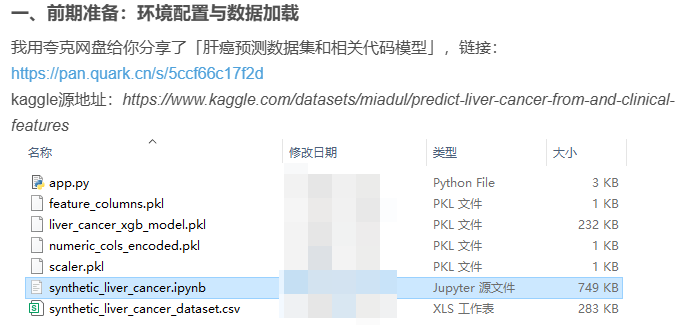
2、进入你存放项目文件的文件夹
点击右侧控制台,cd到你存放文件的地方

3、输入以下命令运行
python
streamlit run app.py
